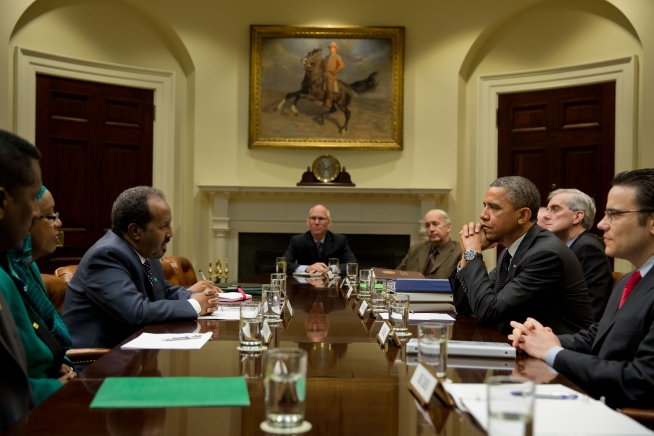
A few weeks ago we reported that the new Somali President (Hassan Sheikh Mohamud) had come to the US, stopped in with Obama and later Hillary Clinton before going on to Minneapolis where he exhorted his fellow Somalis of the “diaspora” to come on back to Africa.
Now, here is a story that Somalis in the City Heights section of San Diego, where there is (incidentally) a Somali terror-funding trial going on, are contemplating a return. And, not only that, but they have been back and forth already.
So this is my fundamental question, if Somalis are traveling safely back and forth to Mogadishu, why are we still bringing in Somalis by the thousands to the US?
Here are the stats for this fiscal year (2013) that began on October 1, 2012. In those four months, we have brought in 2,260 “refugees” from Somalia at a time when the country is considered safe enough for American Somalis to fly back and forth. By the way, in all of Fiscal Year 2011 (when Al-shabaab was at its height) we brought 3,161 Somalis (all year!), so if we continue the pace of the previous 4 months of this fiscal year (when Somalia is safer) we will bring over 6,000! Does that make any sense?
We will pay “church” contractors to resettle them, feed and house them, and educate the kids through college (disrupt communities!).
Wouldn’t it be cheaper to leave them in Africa and help them get Somalia functioning?
Also, remember that countries like Denmark are contemplating refusing Somali asylum seekers because they say Somalia is no longer a complete hell hole, here.
Here is the story from KPBS in San Diego:
The United States officially recognized the Somali government last month for the first time since 1991, alerting Somali refugees in City Heights and throughout the world their homeland is making a comeback.
Somalia has been called “the world’s most failed state,” enduring deadly famines and more than two decades of civil war with al Shabaab militants linked to al Qaeda.
The nation is rebuilding under a newly elected president, who recently urged refugees at a speech in Minnesota, home to the nation’s largest population of Somali refugees, to return to Somalia to help.
But will Somalis who have spent more than 20 years away – some even beginning life outside of their family’s homeland – make the move to Africa?
“The conversation, it’s already among the community,” said Mohamed Ahmed, a 23-year-old Somali living in City Heights. “People have already been back. People are planning to go back. And some people are a bit skeptical about going back and they’re not really comfortable about the situation back home.”
Ahmed left Somalia with his family when he was two months old and came to the U.S. at age of 4. He’s about to graduate from San Diego State University, alongside other East Africans who arrived in America in the 1990s.
He says the timing for a revived Somali state couldn’t be better. Many members of the Somali diaspora are poised to graduate from American and European universities, if they haven’t already.
Ahmed said Somalis who grew up in Europe are returning to work in their native country – at a rate of about 1,000 per month, according to some reports. Flights in and out of Mogadishu have multiplied. Rent has climbed. Last year, young Somali professionals hosted a TEDxMogadishu talk.
Nah! Not so fast! Few will go “home.”
Abdi Mohamoud, executive director of Horn of Africa, a San Diego nonprofit that provides support for local East African refugees, said Ahmed’s drive is common among children of refugees.
“With the tragedy of having so many refugees flee from Somalia, the advantage has become that many of those refugees went to other developed countries and many of them were able to get very high-quality educations,” Mohamoud said. “They’re very eager to try to improve the devastation that their parents have fled.”
But Mohamoud said he’s not convinced many young Somalis will actually make the move to Africa.
Mohamoud went on to say that he predicted 95% would stay in the US.
Remittances! Another word for the “redistribution” of wealth!
The KPBS report also notes this extra cost to the US economy—the same one we reported here regarding El Salvador!
And Somalia’s economy has a long way to go. Currently, remittances from Somali families in City Heights and throughout the world account for about half the nation’s gross domestic product.
